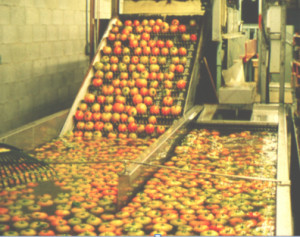Journal of Food Protection®, Number 3, March 2014, pp. 352-521 , pp. 365-370(6)
Zhou, Bin; Luo, Yaguang; Nou, Xiangwu; Yang, Yang; Wu, Yunpeng; Wang, Qin
http://www.ingentaconnect.com/content/iafp/jfp/2014/00000077/00000003/art00003
Salmonella internalization in tomatoes during postharvest handling is a major food safety concern. This study was conducted to determine the effect of immersion time, immersion depth, and temperature differential between bacterial suspension and tomato pulp on the internalization of Salmonella enterica in tomato fruits. The effect of storage temperature and  duration on the survival and growth of internalized Salmonella cells was also evaluated. Overall, immersion time significantly affected the incidence and extent of S. enterica internalization (P < 0.0001), with a linear correlation between immersion time and Salmonella internalization. The depth of Salmonella internalization in tomato tissues also increased with increasing immersion time. Immersion time also significantly influenced the degree to which the temperature differential affected Salmonella internalization. With an immersion time of 2 min, the temperature differential had no significant effect on Salmonella internalization (P = 0.2536). However, with an immersion time of 15 min, a significantly larger Salmonella population became internalized in tomatoes immersed in solutions with a –30°F (–16.7°C) temperature differential. Internalized S. enterica cells persisted in the core tissues during 14 days of storage. Strain type and storage duration significantly affected (P < 0.05) both the frequency detected and the population of internalized Salmonella recovered, but storage temperatures of 55 to 70°F (12.8 to 21.1°C) did not (P > 0.05). These findings indicate the importance of preventing pathogen internalization during postharvest handling.
duration on the survival and growth of internalized Salmonella cells was also evaluated. Overall, immersion time significantly affected the incidence and extent of S. enterica internalization (P < 0.0001), with a linear correlation between immersion time and Salmonella internalization. The depth of Salmonella internalization in tomato tissues also increased with increasing immersion time. Immersion time also significantly influenced the degree to which the temperature differential affected Salmonella internalization. With an immersion time of 2 min, the temperature differential had no significant effect on Salmonella internalization (P = 0.2536). However, with an immersion time of 15 min, a significantly larger Salmonella population became internalized in tomatoes immersed in solutions with a –30°F (–16.7°C) temperature differential. Internalized S. enterica cells persisted in the core tissues during 14 days of storage. Strain type and storage duration significantly affected (P < 0.05) both the frequency detected and the population of internalized Salmonella recovered, but storage temperatures of 55 to 70°F (12.8 to 21.1°C) did not (P > 0.05). These findings indicate the importance of preventing pathogen internalization during postharvest handling.
